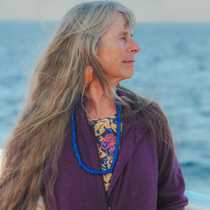Cruising Bahía Loreto Marine Park, visiting Isla Santa Catalina
As the sun rose slightly to the south of Isla Santa Catalina, the National Geographic Sea Bird was making her way north with Isla Del Carmen just off of the bow. Isla Danzante lay directly off the port bow with the Sierra de la Giganta rising above and behind this mountainous gulf island. Slowly, the reds and oranges of sunrise began to color and shadow the mountains of the Baja peninsula as daylight illuminated the world around us. The El Norte wind was beginning its common winter roar! This wind picks up force making its way down North America and funneling straight north down the Gulf of California, bringing a strong wind gusting and blowing everything in its path.
Our natural history staff was stationed on the bow of the National Geographic Sea Bird, scanning for wildlife. These productive waters are well known for marine mammals and this would be the morning we would dedicate to searching for whales and dolphins. Shortly after breakfast an announcement came from the bow of the Sea Bird; our staff had spotted a large, very tall blow. The Captain was driving and began his cautious approach to what proved to be a very cooperative and large blue whale.
During the next hour we spent time maneuvering the National Geographic Sea Bird for closer looks at our planet’s largest mammal. Close looks were had by everyone on the bow, including everyone on the starboard side of the forward lounge, one deck lower in the vessel! This particular blue whale returned to the surface at regular intervals and remained on the surface long enough for our Captain to maneuver the Sea Bird into position for a close look at the characteristic small dorsal fin and mottled bluish-gray colored skin. Another added bonus to this particular sighting was that our morning visitor was a blue whale who showed its fluke! Several of the dives we observed provided the spectacle of a blue whale fluke that was over 20 feet across!
All too soon it was time to make a crucial decision about moving to our afternoon anchorage of Isla Santa Catalina. The El Norte wind continued to churn up the waters of the Bahía Loreto Marine Park, and our crossing to Isla Santa Catalina was just over 15 miles in length. At approximately 10:30am we began our passage in slightly rough seas. During our crossing Gretchen regaled us with a presentation, including images and stories of desert plant strategies, giving us some preparation for this afternoon’s hikes.
Once around the southern tip of Isla Santa Catalina, we moved slightly north and then into the protection of Bahía Elephante, where the Sea Bird dropped anchor in calm waters. From this anchorage we would have the chance to snorkel under Elephante Rock, then move ashore for a variety of hikes. Visibility for snorkeling was excellent and provided a glimpse of the richness of the waters of the Gulf of California. Snorkelers had looks at moorish idols, giant damsels and many, many sergeant majors! Meanwhile, long hikers were ferried ashore for a three-mile walk to a high ridge for a view over the Gulf and distant Baja peninsula.
Soon snorkelers returned to the Sea Bird, changed clothes and joined other moderate hikers for a casual wander up the main arroyo of Isla Santa Catalina. Timing was perfect for this late afternoon hike. The late afternoon light was soft, the air warm, and the landing was protected from the El Norte wind. Moderate hikers made their way into the arroyo, finding one small treasure after another. A loggerhead shrike was seen nestled in a shrub. After closer examination we found that this great hunter was guarding a small lizard that the shrike had impaled on a nearby sharp twig! As our group got closer, the shrike grabbed its feast and flew to another shrub for an early dinner.
Moving deeper into the arroyo, Costa’s hummingbirds could be heard scolding the intruders, who were of course admiring their territory which included the red flowers of the parasitic plant Toji. Hovering like the tiniest helicopter one could imagine, these very small birds tipped their beaks into the long tubular flowers of the Toji for a quick burst of energy provided by the flower’s nectar.
All too soon it was time for all hikers to return to the beach and begin the shuttling back to the waiting Sea Bird. We would remain at anchor for most of the evening, giving everyone a chance to enjoy recap, and a good meal. After our ship was secure, we would make our way back out into the El Norte that continued to churn the Gulf of California. We would cross the short distance back into the protection of a necklace of islands that line the eastern side of the Baja peninsula and continue our exploration of this diverse and unique spot on the planet called “a desert by the sea.”




